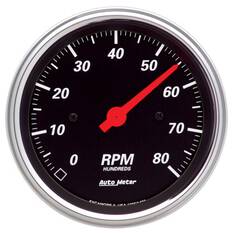Top Reasons That Every Motorist Needs a High-Quality Tachometer
Top Reasons That Every Motorist Needs a High-Quality Tachometer
Blog Article
The Value of a Tachometer in Checking Engine Speed and Efficiency in Automotive Applications
In the realm of automotive engineering, the tachometer stands as a pivotal instrument in the motorist's collection, supplying a straight window right into the inner functions of a lorry's engine. Past its function as a plain scale of transformations per min (RPM), the tachometer serves as an important tool for fanatics and experts alike, using real-time insights into engine performance and health.
Importance of Keeping An Eye On Engine RPM
Checking engine RPM, or changes per minute, is an essential aspect of vehicle maintenance and performance analysis. Engine RPM directly correlates with the rate at which the engine's crankshaft revolves, suggesting how quickly the engine is running - tachometer. By checking RPM, auto mechanics can examine the health and wellness of the engine, identify prospective concerns, and fine-tune performance. An uncommon RPM reading may indicate issues such as engine misfires, faulty spark plugs, or problems with the gas delivery system. Constantly high RPM analyses might show hostile driving habits or the requirement for a greater equipment shift to enhance gas performance.
Furthermore, keeping track of engine RPM is vital for performance examination in racing and high-performance vehicles. Keeping optimal RPM levels is essential for attaining peak power output and acceleration. Racers often use tachometers to guarantee they are running within the ideal RPM variety for optimum performance. In recap, keeping track of engine RPM is not only important for discovering issues yet additionally for optimizing engine performance in various auto applications.

Advantages of Real-Time Data
In auto applications, real-time information plays a vital role in giving instantaneous understandings into the efficiency and problem of the lorry. By constantly keeping an eye on different parameters such as engine rate, temperature level, fuel usage, and a lot more, real-time information uses various advantages that contribute to boosted performance and security on the road.
In addition, real-time information helps with performance optimization by providing prompt comments on driving behaviors and engine effectiveness. Motorists can adjust their behavior in real-time based on this info to attain better gas economic climate and lengthen the life expectancy of their car.

Moreover, real-time data plays an important duty in contemporary automotive diagnostics, allowing service technicians to promptly detect and attend to malfunctions. This brings about decreased downtime, reduced upkeep prices, and ultimately, boosted total lorry dependability and durability (tachometer). By harnessing the power of real-time information, vehicle stakeholders can make educated choices that favorably impact both the efficiency and longevity of the automobile
Effect On Gear Shifts
Efficient gear shifts in auto applications considerably influence total efficiency and driving experience. The tachometer plays a critical role in enhancing gear changes by supplying real-time engine rate data to the chauffeur. When approaching the redline on the tachometer, it indicates the driver to upshift to protect against over-revving the engine and triggering possible damages. On the various other hand, downshifting at the right minute can assist preserve the engine in its power band, guaranteeing responsive velocity when needed.
In addition, the tachometer aids in accomplishing smoother equipment shifts, especially in hands-on transmissions. By monitoring engine speed, vehicle drivers can perform gear changes at the optimum RPM range, decreasing snagging motions and reducing endure the transmission parts. This accuracy on duty changes not only enhances pop over to this web-site driving comfort however additionally adds to sustain performance.
Enhancing Fuel Performance
Provided the critical duty the tachometer plays in maximizing gear shifts for efficiency and engine wellness, it directly adds to making the most of fuel performance in vehicle applications. By supplying real-time responses on engine rate, the tachometer helps vehicle drivers in keeping the most effective RPM array for gas economic climate. When content vehicle drivers regularly keep an eye on the tachometer and adjust their motoring routines appropriately, they can stay clear of unnecessary gas usage brought on by over-revving or hauling the engine.
Moreover, the tachometer assists vehicle drivers recognize the most fuel-efficient equipment to be in at any kind of given moment, stopping the engine from working tougher than necessary. This is specifically crucial throughout velocity and travelling, where remaining in the right equipment can dramatically influence gas performance. In addition, the tachometer can signal chauffeurs to potential mechanical problems that could be negatively impacting fuel economic climate, such as a sliding clutch or a blocked air filter. To conclude, the tachometer works as a valuable tool in improving gas effectiveness by promoting optimum driving habits and recognizing areas for renovation in the lorry's read review performance.

Making The Most Of Engine Longevity
The tachometer's function in checking engine speed and performance is critical in guaranteeing the durability of automotive engines. Keeping track of the tachometer allows vehicle drivers to remain within the recommended RPM array for their vehicle, avoiding unnecessary pressure on the engine and prolonging its life expectancy.

Final Thought
In conclusion, the tachometer plays a crucial role in keeping track of engine rate and performance in automotive applications. By offering real-time information on RPM, it allows for effective gear shifts, enhanced gas performance, and made the most of engine longevity. This tool is necessary for preserving optimum engine efficiency and ensuring the total capability of a lorry.
Report this page